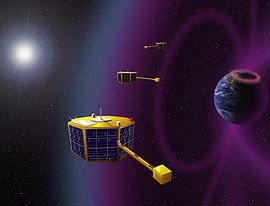
Back Space Technology 5 German Space Technology 5 Spanish Space Technology 5 French Space Technology 5 HE ST5 (NASA) Japanese Space Technology 5 Polish
 Artist's rendering of the "string of pearls" satellite constellation | |
| Operator | NASA / GSFC |
|---|---|
| COSPAR ID | 2006-008A through 2006-008C |
| SATCAT no. | 28980 through 28982 |
| Website | nmp.jpl.nasa.gov/st5 |
| Mission duration | 18 years, 5 months and 12 days (in orbit) |
| Spacecraft properties | |
| Manufacturer | UCLA Kennedy Space Center New Mexico State University Physical Science Laboratory |
| Launch mass | 25 kilograms (55 lb) |
| Power | ≈20–25 W @ 9–10 V |
| End of mission | |
| Deactivated | June 30, 2006 |
| Orbital parameters | |
| Reference system | Geocentric |
| Regime | Sun synchronous |
| Eccentricity | 0.239 |
| Perigee altitude | 300 km (190 mi) |
| Apogee altitude | 4,500 km (2,800 mi)[1] |
| Inclination | 105.6° |
| Transponders | |
| Band | X-Band |
| Bandwidth | 1 Kbps / 1 or 100 Kbps |
Space Technology 5 (ST5) of the NASA New Millennium program was a test of ten new technologies aboard a group of microsatellites. Developed by NASA Goddard Space Flight Center, the three individual small spacecraft were launched together from the belly of a Lockheed L-1011 aboard the Pegasus XL rocket, on 22 March 2006. One technology involved antennas that were designed by computers using an evolutionary AI system developed at NASA Ames Research Center.[2] The ST5 on-board flight computer, the C&DH (Command & Data Handling) system, was based on a Mongoose-V radiation-hardened microprocessor.
On 30 June 2006 the satellites making up ST5 were shut down after successfully completing their technology validation mission.[3]
- ^ "ST5 Quick Facts". nmp.jpl.nasa.gov. Archived from the original on 2006-01-18.
- ^ "Evolutionary Design of an X-Band Antenna for NASA's Space Technology 5 Mission" (PDF). ti.arc.nasa.gov. NASA. 2004. Archived from the original (PDF) on 2011-10-18.
- ^ "ST5 Mission". nasa.gov. NASA. December 20, 2007.
© MMXXIII Rich X Search. We shall prevail. All rights reserved. Rich X Search